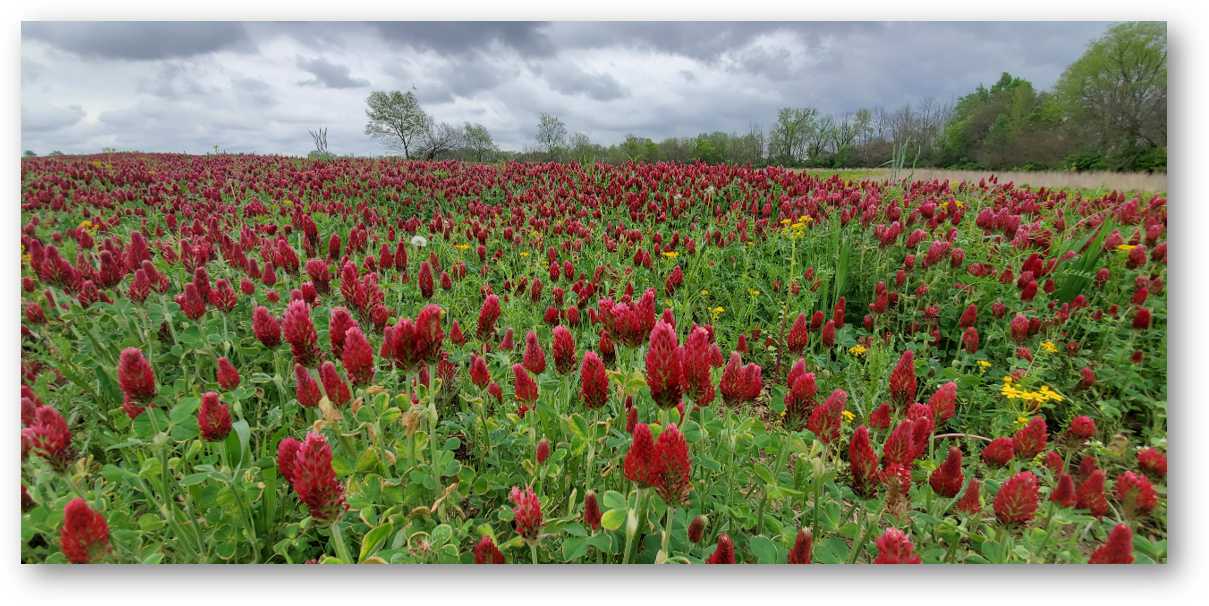 Crimson clover is a late summer-seeded nitrogen-fixing annual legume that will typically overwinter. It is best seeded after wheat.
Crimson clover is a late summer-seeded nitrogen-fixing annual legume that will typically overwinter. It is best seeded after wheat.
It is a top nitrogen producer (75-100 lbs. N/acre) when planted early and allowed to reach bud stage.
Seeding Rate (lbs. / acre)
- Drill: 12-20
- Broadcast: 15-20
- In a mix: 5-10
– Planting depth: 1/8”–1/4”
– Approximate seeds/lb: 150,000
– Days to germination: 7–10
Crimson Clover Benefits & Info
- It is a semi-upright legume needing 6 weeks of growth in the fall before a killing frost
- It performs well in mixes, especially with annual ryegrass and radishes
- Overwintering likelihood increases with snow cover in northern climates
- Known for its fine, fibrous root system, shade tolerance, and quick establishment
- Crimson clover is easy to spring terminate
- Its shade tolerance makes it suitable for inter-seeding
- Crimson clover fields allowed to reach the flower stage have proven to be attractive to pollinators and beneficial insects
- WATCH OUT – thick, dense stands have been known to attract voles and other unwanted pests
Forage Considerations
- Crimson clover is a good option for hay/grazing, but it can cause bloat when unmanaged
Ewing Demo Trial
October 12 planting date. April 22 harvest. 214 days after planting.
- FIXationN Balansa Clover = 96,154 lbs./acre of green biomass
- Frosty Berseem Clover = 47,773 lbs./acre of green biomass
- Kentucky Pride Crimson Clover = 18,421 lbs./acre of green biomass
- Dixie Crimson Clover = 5,162 lbs./acre of green biomass
See the full trial here.
The Importance of Improved Varieties
Crimson clover is a big player in the clover world. With the price point of crimson this year, I found myself using it quite a bit. The benefits of crimson are lengthy – produces N, prevents erosion, makes great forage, and smothers weeds. Here are three improved varieties of crimson clover:
Dixie
This variety is very popular throughout the Midwest because of its tolerance to many different soil types. It came from the southwest, which is also where the “Dixie” name came from. This variety is considered an early maturing, re-seeding variety. It does best if seeded at least 6 weeks before a hard frost. Dixie is the “old faithful” when it comes to crimson clover.
Kentucky Pride
This variety is a deeper-rooted, more cold-tolerant, later maturing (about 2 weeks) variety than Dixie. Offering all the same benefits as Dixie, it may help alleviate compaction a little better with its more robust root system. It is also best to use this in the more northern parts of our territory if you want it to over-winter/grow later into the fall. Kentucky Pride tolerates temperatures 10 to 15 degrees cooler than Dixie. This extended growing season generally offers more tonnage come spring.
White Cloud
This variety is the only white flower crimson clover on the market. Manage it like you would Dixie. White Cloud’s claim to fame is its increased protein levels and high sugar content. Because of its white flowers, there are lower amounts of bitter anthocyanins. This gives the plant a sweeter taste and animals tend to prefer this variety over the crimson-colored varieties. Although more palatable, it does not re-seed as well as Dixie or Kentucky Pride. My advice would be to over-seed in the fall.
Sarah Houin, Agronomist







